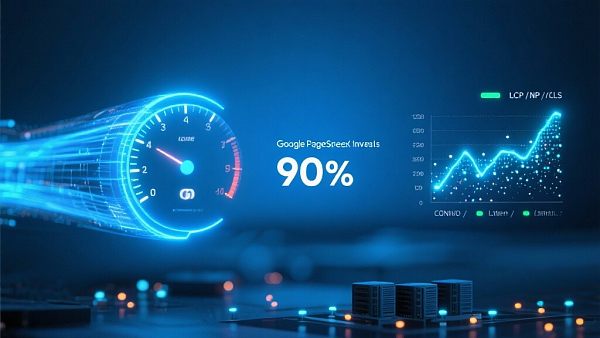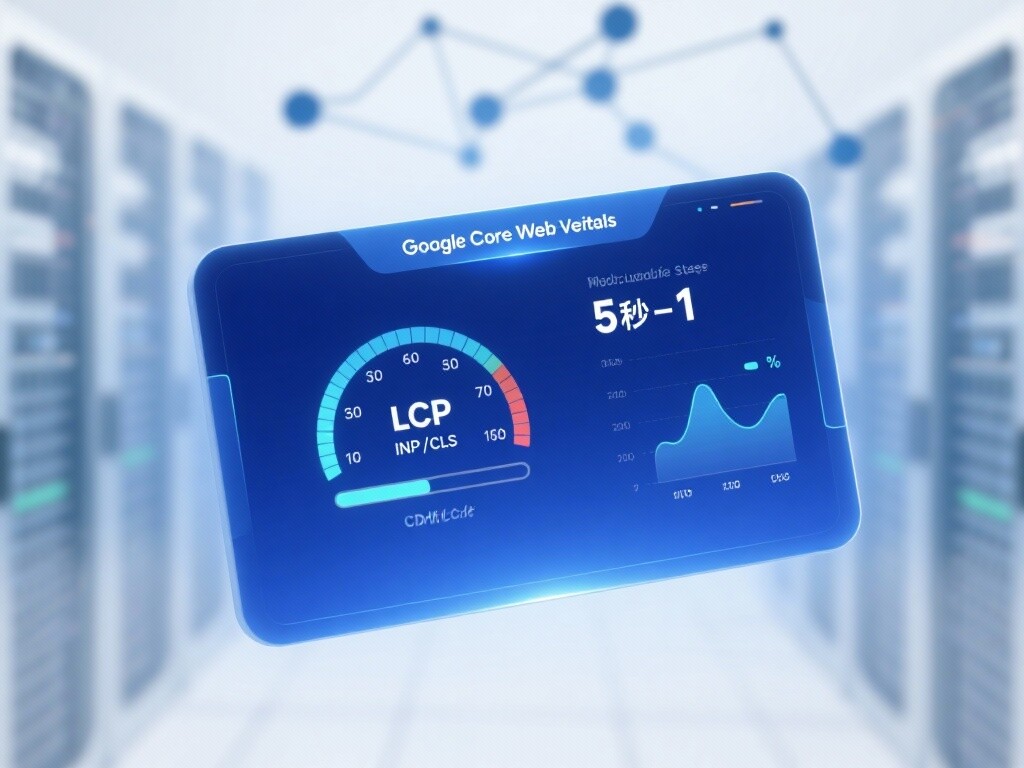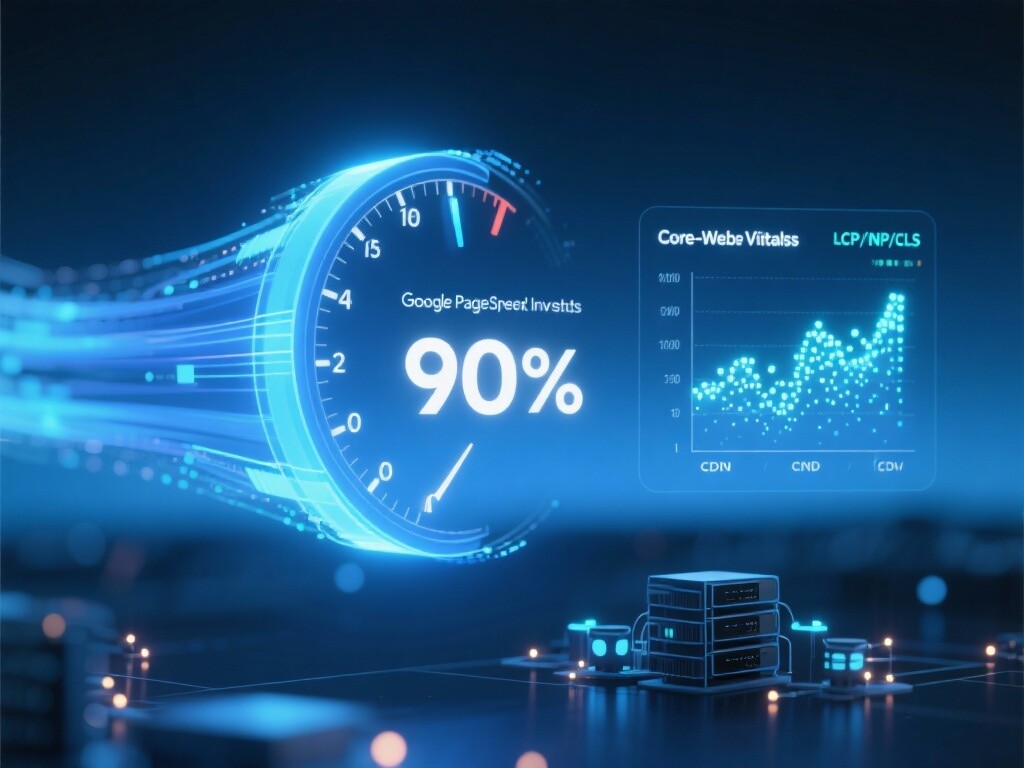I. The Authoritative Definition, Strategic Core, and Development History of Website Loading Speed Optimization Services
1. The Authoritative Definition and Key Elements of Website Loading Speed Optimization Services
**Website Loading Speed Optimization Services** are specialized performance engineering services aimed at ensuring websites achieve **extremely fast response, rendering, and interaction** under various devices and network conditions through systematic **frontend code optimization, server configuration tuning, network transmission optimization, and resource management**. The core objective is to ensure websites meet the "Good" standard across all **Google Core Web Vitals** metrics, thereby maximizing SEO rankings and user conversion rates. Key elements include: **CWV optimization, critical path optimization, CDN strategies, and server performance tuning**.
2. The Three Irreplaceable Strategic Values of Website Speed Optimization
Speed is the intersection of SEO, user experience, and conversion:
- **Direct Impact on Google Rankings:** Speed is officially recognized by Google as a **core ranking factor**. Achieving CWV benchmarks is the **entry ticket** for high rankings, especially for competitive keywords where speed is the key to outperforming rivals.
- **Significantly Reduces Bounce Rates and Improves User Experience (UX):** Research shows that if a website takes over 3 seconds to load, the **bounce rate increases by 32%**. Speed optimization directly enhances user satisfaction, dwell time, and repeat visit rates.
- **Directly Boosts Conversion Rates (CVR):** For e-commerce or B2B inquiry websites, every 1-second reduction in loading time can **increase conversion rates by an average of 7%**. Speed optimization is one of the most effective methods for achieving **high conversion rates (CRO)**.
3. The Evolution and Technological Advancements of Website Speed Optimization
Early Stage (2000s): Optimization focused primarily on **file compression**. Mid-Stage (2010s): Technologies shifted toward **browser caching, Gzip compression**, and began emphasizing **server response time (TTFB)**. Modern Era (2020s–Present): Entered the **user-centric Core Web Vitals era**, with a technical focus on **critical rendering path optimization, AI-driven resource preloading, and deep optimization of INP (Interaction to Next Paint) metrics**.
II. The Five Core Technical Principles of Website Loading Speed Optimization: Focusing on CWV and Critical Path Optimization

The underlying technical logic for achieving Google’s "Good" speed rating:
1. Core Web Vitals (CWV) Optimization Principles
Principles: CWV includes LCP, INP, and CLS. Best Practices:
- **LCP (Largest Contentful Paint):** Optimize **priority loading of above-the-fold images/elements**, use responsive images and next-gen formats (WebP).
- **INP (Interaction to Next Paint):** Optimize **JavaScript execution efficiency**, break down large tasks to ensure quick responses to user clicks or inputs.
- **CLS (Cumulative Layout Shift):** Optimize **size reservations for images, ad slots, and embedded content** to prevent unexpected element shifts during loading.
2. Critical Rendering Path (CRP) Optimization Principles
Principles: Browser rendering of above-the-fold content requires multiple steps. Best Practices: Minimize **CSS, asynchronously load non-critical CSS/JS**, and inline **Critical CSS** to reduce browser blocking time and accelerate above-the-fold content display (directly improving LCP).
3. Time to First Byte (TTFB) and Caching Strategy Principles
Principles: TTFB (Time To First Byte) is the time the browser receives the first byte, heavily dependent on server performance. Best Practices: Optimize **server configurations (e.g., Gzip/Brotli compression), database queries, efficient page-level caching (Redis/Memcached)**, and deploy **global CDNs** to reduce network latency at the source.
4. Image and Multimedia Resource Optimization and Lazy Loading Principles
Principles: Images are often the biggest bottleneck. Best Practices: Apply **lossless compression**, convert to **WebP/AVIF** formats. Use **Lazy Loading** for non-critical images and **Preload** for key product images to prioritize resource loading.
5. Code Splitting and Resource Hints Principles
Principles: Large JS files block rendering. Best Practices: Use **tools like Webpack to split JS code**, loading only required modules. Apply **Resource Hints (e.g., preconnect, prefetch, preload)** to guide browsers in pre-establishing connections or fetching future resources, eliminating delays.
III. The Four Core Technical Features and Applications of Website Loading Speed Optimization Services
1. Technical Feature: Global CDN and Intelligent Edge Computing Deployment
Feature: Distribute website content globally via edge servers, delivering it from the nearest node to users. Application: Ensures **millisecond-level access speeds for clients in Europe, North America, or Southeast Asia**. CDNs also absorb traffic spikes and DDoS attacks, enhancing stability and security.
2. Application: Accelerating Checkout Flows for E-commerce/DTC Websites
Application: Speed is critical for **cart and checkout pages**. Optimization services focus on **INP optimization** and **preloading key JS files** to minimize payment delays, directly reducing **cart abandonment rates**.
3. Application: LCP Optimization for B2B Inquiry Pages
Application: For B2B, **above-the-fold CTAs and trust elements** must load instantly. Optimization services ensure **Critical CSS inlining and resource preloading**, so inquiry forms and certifications appear immediately, boosting conversion opportunities.
4. Application: Performance Boosts for Large CMS (WordPress/Shopify) Systems
Application: For enterprises using mainstream CMS, optimization services include **database cleanup, plugin audits, advanced caching, and theme code reviews** to resolve inherent CMS performance issues and maximize efficiency.
IV. Comparative Analysis of Speed Optimization Services vs. Traditional IT Maintenance and Industry Scenarios

1. Speed Optimization Services vs. Traditional IT Maintenance: A Comparative Analysis
2. Typical Industry Scenarios for Website Loading Speed Optimization Services
Speed optimization is a core competitive advantage in these industries:
- **Cross-border E-commerce/DTC Brands:** Every millisecond of delay means lost orders. Speed optimization directly improves **ad ROI and cart conversion rates**.
- **B2B Heavy Equipment/Industrial Products:** Clients often download **large product manuals or high-resolution images**. Speed optimization ensures fast loading, improving inquiry submission rates.
- **High-Tech/SaaS Services:** Website speed reflects technical prowess and professionalism. Optimization builds **stronger E-E-A-T authority**.
3. Certifications and Professional Standards for Website Loading Speed Optimization Services
Criteria for evaluating professional speed optimization services:
- **Google PageSpeed Insights Commitment:** Providers should guarantee key pages score **above 90** with all CWV metrics achieving "Good."
- **Quantifiable TTFB Metrics:** Commit to reducing **Time To First Byte (TTFB)** to industry-leading levels (typically under 200ms).
- **CDN and Global Network Certification:** Partner CDN providers must have **global coverage and ISO 27001 certifications**.
V. Schedule a CWV Diagnostic Now to Eliminate Your Website’s Speed Bottlenecks!
Is your website **losing Google rankings and high-value clients due to slow loading speeds**? Every delay is a massive blow to your brand’s professionalism and conversion rates! Our **Website Loading Speed Optimization Services** leverage cutting-edge **Core Web Vitals performance engineering** to achieve **millisecond-level loading speeds**, instantly boosting **SEO rankings, reducing bounce rates, and directly increasing conversions**. Schedule a **free "Website CWV Deep Diagnostic Report"** to identify your performance gaps!
Click to Get a Free CWV Diagnostic ReportFAQ
1. What key issues do website loading speed optimization services address, and how do they impact SEO?
Answer: Primarily addresses **Core Web Vitals (LCP, INP, CLS) underperformance, slow server response (high TTFB), and poor mobile performance**. Since CWV is a Google core ranking factor, optimization directly** improves keyword rankings**, while indirectly strengthening rankings through improved user behavior metrics (lower bounce rates)**.
2. After optimizing my website’s loading speed, how much can I expect my conversion rate (CVR) to improve?
Answer: Improvement varies by industry, but data shows reducing load time from 5 to 2 seconds,** lowers bounce rates by over 20%**. Google research indicates every 0.1s improvement in mobile speed,** increases conversions by 8%**. Our goal is to achieve** double-digit percentage conversion rate improvements** for you.
3. Does optimization require replacing my current server or CMS system?
Answer: Not necessarily. We first optimize** frontend code and resource management**. If server (e.g., TTFB) or CMS configurations are clear bottlenecks, we’ll propose** professional upgrades or optimizations**, but the final decision rests with you. Our goal is to achieve** maximum performance gains with minimal system changes**.
4. How do I know if my website’s speed optimization meets international standards?
Answer: International standards primarily reference **Google PageSpeed Insights** scores and **Core Web Vitals reports**. We commit to pushing key pages to** 90+ scores**, ensuring all CWV metrics achieve** "Good"**. We also provide **Google Search Console** real-user data (Field Data) for performance validation.

Customer Reviews
CEO Chen, North America DTC Outdoor Equipment E-commerce
"We previously spent a lot of money on ads, but the conversion rate remained stagnant. After introducing website loading speed optimization services, our **mobile LCP speed increased by 65%**, **INP on checkout pages dropped below 100 milliseconds**. The most direct result was that **cart abandonment rate decreased by 15%**, **overall ad ROI improved by 28%**, with immediate and visible effects."
Marketing Director Li, Europe B2B Industrial Equipment Manufacturer
"Our website had many high-resolution product images and technical documents, and the speed was always slow. Through this service, they not only optimized the images but also deployed a **global CDN**. Now the website loads extremely fast in Europe and the US. More importantly, our **CWV reports in Google Search Console all turned green**, **many core keywords also entered the first page in rankings as a result**."


